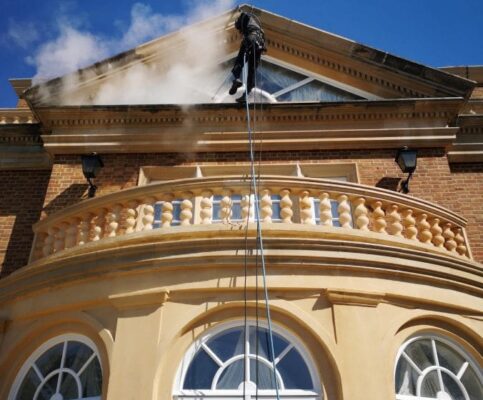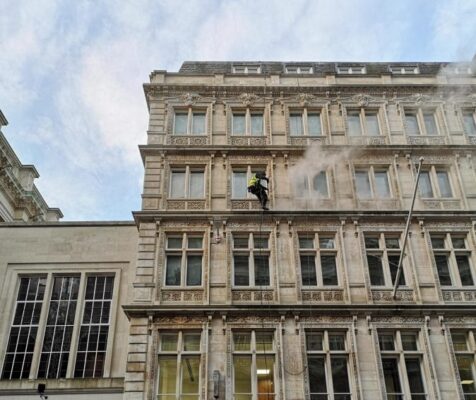View More SErvices Contact Us
Facade Cleaning in Highbury
Cleaning building facades from top to bottom, no matter how tall your building.
Natural stone facade cleaning in Highbury can be accessed and cleaned efficiently and effectively by using rope access methods. Using this method, the need for local authority permits is totally eradicated, allowing works to proceed immediately. Using professional stone cleaning equipment we can roll back the years to make your building look like new.
Brick cleaning
Brick buildings become dirty as much as any other building. We will not only clean away the dirt and grime, we can revitalise the colour. Using a range of bio-degradable chemicals, we can restore the colour of red or yellow bricks.
Contact UsGlass facade cleaning in Highbury
Glass facade cleaning in Highbury takes place by abseilers using traditional window cleaning tools. External windows, internal atriums, after builders cleaning or regular maintenance cleans, our abseilers are experienced in all manner of glass cleaning.
Contact UsAluminium cladding cleaning
Aluminium cladding in Highbury can become extremely dirty over time. Warehouses that have many lorries coming and going will become soiled with traffic film. Using our steam cleaning systems, this grime is washed away leaving a lasting first impression for your visitors.
Contact UsOur services
Rope Access Facade Cleaning Services for Highbury And Surrounding Counties

Residential property Stone Facade Cleaning
Façade cleaning at this residential property in Highbury, which was not of any great height but, had no access for other forms of access equipment. Abseiling was the solution and the results were outstanding.

Stone Steam Cleaning in London
This beautiful natural stone building was looking tired from the day to day London traffic. Rope access was seen as the most cost-effective method of access.

Concrete Facade Cleaning in Highbury
This car park in Essex was filthy. It hadn’t been cleaned, ever. As the access to three elevations was extremely tight, abseiling was the only method that could achieve the results.

Facade Cleaning in Highbury
A new acquisition for our client needed a freshen up. Out of hours abseiling was the best way to clean this building in the heart of the City of London.
Brick colour restoration
Before colour restoration
This client requested a test patch before assigning us the job of cleaning their building. We carried this out with amazing results.
After colour restoration
These are the pictures of the test patch that we sent to the client. Her reaction was simply ‘WOW’. That’s the perfect response for us.
Torik Stone Cleaning System Features
150 degrees centigrade steam cleaning power
Provides a continues flow of superheated water to penetrate stone and deep clean, removing organic growth & ground in dirt.
We use Tensid (uk) Ltd
Providers of specialist cleaning equipment and specialist cleaning chemicals to professionals.
Get In Touch
Fill in the form below and we’ll be in touch within 24hrs of receiving your message.
Facts About Highbury
Highbury History
By 1794 Highbury consisted of Highbury House and Highbury Hill House, Highbury Barn and the gated terraces of Highbury Terrace and Highbury Place, which had been built on land leased by John Dawes. Highbury may have stayed this way, as the plan was to create a 250 acres park – Albert Park – between St Paul’s Road/Balls Pond Road and the Seven Sisters Road.
In 1913 Woolwich Arsenal F.C. moved north to Highbury, dropping Woolwich from its name. Their chairman Sir Henry Norris took a 20-year lease on part of the grounds of St John’s Hall for £20,000. The new Arsenal Stadium was built there. St John’s Hall, originally called Highbury College, was built in 1825 on what is now Aubert Park and was a grand ionic-style building, reminiscent of the British Museum.
General Info
Highbury is a district in North London and part of the London Borough of Islington that was owned by Ranulf brother of Ilger and included all the areas north and east of Canonbury and Holloway Roads. The manor house was situated by what is now the east side of Hornsey Road near the junction with Seven Sisters Road. After the manor decayed, a new manor house was built in 1271 to the south-east.
To differentiate it from the original manor and because it was on a hill, it was called Highbury, from which the area takes its name. The site for Highbury Manor was possibly used by a Roman garrison as a summer camp. During the construction of a new Highbury House in 1781, tiles were found that could have been Roman or Norman; however, these have been lost.



